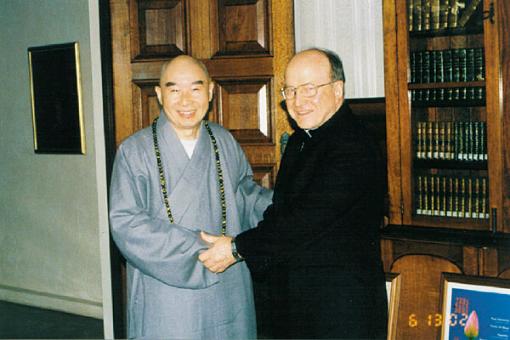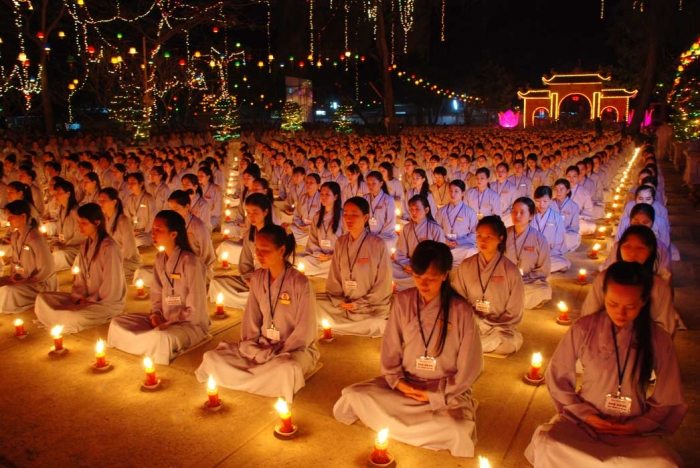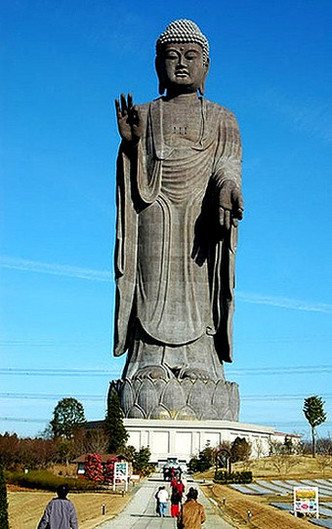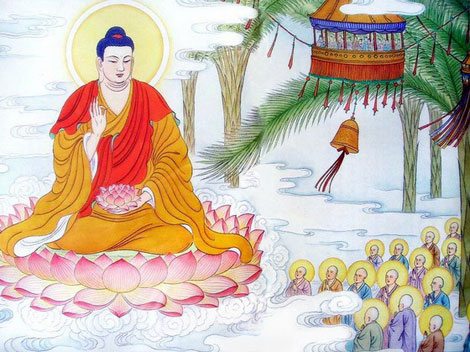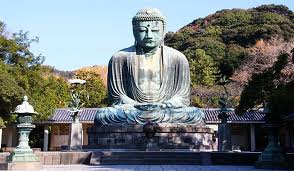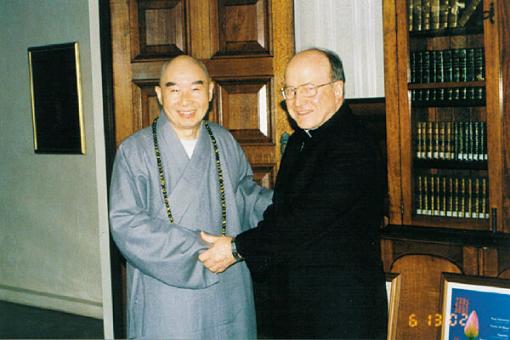
Master Chin Kung and the Archbishop of Brisbane
The Buddha spoke repeatedly of the Pure Abodes in the Pali Canon and taught that the sentient beings of the Pure Abodes were safely beyond the reach of the desire realm, never again to be reborn as a hell-dweller, a hungry ghost, an animal, a god of strife, a human, or an unenlightened god.
The Mahayana practice is to recite the name of Amitabha Buddha, the Buddha of infinite light and life. We don’t count the number of recitations.
Buddha Name Recitation in Viet Nam
Pure Land practitioners teach that Buddha Name Recitation is the only practice one needs to ensure re-birth in the Land of Ultimate Bliss, i.e., the Pure Land. They recommend recitation practice for people who have trouble with meditation.
With daily Buddha Name Recitation, we assure rebirth in The Pure Land, never again to descend into the lower six realms.
We are not reciting the name of Amitabha Buddha. Amitabha Buddha is reciting Amitabha Buddha.
The sixth fold of the eightfold path is right effort. The Buddha divided right effort into four efforts: 1) Nipping evil/unwholesome thoughts in the bud as they begin to arise; 2) Abandoning evil thoughts that have arisen; 3) Planting wholesome thoughts if our thoughts are neutral; and 4) Nurturing wholesome thoughts that have already arisen.
Buddha Name Recitation practice is an ideal way to practice the four right efforts.
1) Whenever we notice our thoughts taking a negative turn, we recite the name of Amitabha Buddha.
2) If we fail to notice that moment and are already awash in negative thoughts, we drop them by reciting the name of Amitabha Buddha.
3) If we notice that our thoughts are neutral, we recite the name of Amitabha Buddha.
4) If we notice that our thoughts are wholesome, we maintain those wholesome thoughts by reciting the name of Amitaba Buddha.
Amitabha Buddha is not an “other.” We are reciting our own name, remembering who we are.
With whole-hearted and unbroken daily practice of Buddha Name Recitation, we leave the realm of the unenlightened gods and thus leave the six worlds referred to in Master Hakuin’s chant, i.e., the tenth, ninth, eighth, seventh, sixth, and fifth dharma realms, the realms of desire.
The four upper dharma realms are the heavenly dharma realms. The sentient beings in the heavenly dharma realms can never fall back into the six worlds, the bottom six realms.
I once attended a Buddhist Summer Camp in Orlando and after a monk-delivered talk on Buddha Name Recitation, a member of the audience said her practice was to chant One, One, One. She asked the monk if that was a good practice and he said:
“You can chant something that you have developed for your personal use, but you will be chanting alone.”
Buddhism is flourishing in the Republic of China (Taiwan) as well as in the People’s Republic of China (the mainland) so if we chant the Mandarin Namo Amituo Fo, we will not be chanting alone.
Very few people chant Namo Amitabha Buddha, the Sanskrit version, but millions chant Namo Amituo Fo.
The fourth dharma realm, that of the Pure Land or the Pure Abodes, is the lowest of the four heavenly realms, but the step from the fifth to the fourth dharma realm is the second biggest step of all because it is the step from the six worlds to the heavenly realms, it is the step of no return. Buddha Name Recitation helps us make that leap.
Moreover, making the effort, every day, to practice Buddha Name Recitation as much as possible by following the four right efforts, samma vayama, helps us to develop the sixth fold of the eightfold path. Whenever we catch ourselves daydreaming or singing a catchy pop tune in our head, we switch to singing Namo Amituo Fo instead. If we are stuck in traffic, we know what to do instead of getting peeved.
Turning to Buddha Name Recitation whenever we can remember to do so gradually clears out the mental cobwebs created by the onslaught of pop culture.
If we practice with diligence, every day, we learn that the dharma realms are real. The Pure Abodes is not a fantasy land.
The Pure Land sect, like Zen, is a Mahayana sect and therefore is practiced primarily in the Mahayana countries of China, Japan, Korea, and most of Viet Nam.
The Buddha mentioned the Pure Land when he discussed the four levels of enlightenment in the Pali canon: the stream winner, the once-returner, the nonreturner and the fully enlightened one.
Venerable Ajahn Brahm in Mindfulness, Bliss and Beyond cites the commentary on the Anguttara Nikaya for his observation that:
“Nonreturners have advanced even further to completely eliminate all desire within the world of the five senses and ill will. Should they not win full enlightenment at the time of their death, then they will arise in the pure abodes (suddhavasa) to attain full enlightenment there. They are never again reborn in the human world.”
This passage from the Pali canon, and many other passages that refer to “the pure abodes” did not inspire the Theravada school to speculate at length about the pure abodes where one may practice until full enlightenment, samyak sambodhi, is attained wihout fear of falling back into the six worlds.
But the Buddha’s multiple references to the Pure Abodes inspired great interest in the Mahayana school.
Since there is nothing outside us, we make our own world. We take ourselves to the hell worlds, the heavenly realms, the human dharma realm, the animal realm, and so on. As practitioners, we might as well take ourselves to the pure abodes, the Pure Land, the Land of Ultimate Bliss.
The Pure Land is described in the Mahayana sutras as a place that sounds to westerners like the Christian heaven. However, instead of sitting around singing hosannas to the King as in the Christian heaven, the beings in the Land of Ultimate Bliss are cultivating Buddhahood.
Unlike the earth, where cultivation is not always easy, practicing zazen and other forms of cultivation is said to be easy in the Pure Land where everyone is a cultivator.
Pure Land practice requires Faith, Vows, and Practice. The following vow to be reborn in the “Western Pure Land” is recited at the end of a practice period:
“I wish to be reborn in the Western Pure Land, with the nine grades of lotus blossoms as my parents. When the lotuses are in full bloom, I shall see Buddha Amitabha and be enlightened to the Absolute Truth, with non-retrogressing Bodhisattvas as my companions.”
Such a recital strikes us Westerners as bizarre but with repetition it becomes beautiful.
By the way, the term “western” does not refer to the western hemisphere which was of course unknown to easterners when the Pure Land School developed, long before 1492.
Here is my non-scholarly theory of why they called the Pure Land the Western Paradise:
It is known that the ancient Chinese preferred to build their homes facing the south to derive maximum benefit from the sun. Facing south, they knew that the Pacific was to their left and straight ahead so they assumed the Pure Land was to their right. And the west is to the right when facing south.
That’s my theory, but like the lady chanting “One,” I probably hold it alone.
The real reason is that the sun sets in the West, and the setting sun represents the end of sense desire or the cessation of ignorance. Thus the sun goes to the Western Paradise each night.
The practice or reciting the name of Amitabha Buddha is reminiscent of the Biblical injunction to “pray without ceasing.” The practice is usually called Buddha Name Recitation or simply Buddha Recitation. English speakers are sometimes encouraged to chant in Sanskrit: “Namo Amitabha Buddha.” The term “namo” looks like the forerunner of the English work “name” but scholars translate it as “praise.”
Amitabha Buddha is not Shakyamuni Buddha, the historical Buddha who announced the Four Noble Truths and taught The Anapanasati Sutta. According to the Mahayana sutras, Amitabha Buddha is a prehistoric Buddha, a Buddha of times that were ancient even during the lifetime of the historical Buddha. Amitabha Buddha vowed to help all sentient beings to awaken if they would but call upon his name.
In Japanese, the Buddha Name Recitation is “Namu Amida Butsu.”
Chinese Buddhists (and others influenced by Buddhism as developed in China) routinely greet and say goodbye to one another with hands palm-to-palm and the words “Amituo Fo.” (“Fo” is Mandarin for the Buddha).
So “Amituo Fo” is used among Chinese Buddhists in the same way as is “Aloha” in Hawaii. A good translation of “Aloha” is: “May you be well, happy, calm and peaceful.”
Worldwide, practitioners of The Pure Land school outnumber Zen practitioners. Some observers conclude that The Pure Land School is for the masses and Zen is for the elite. Au contraire!
Such observations are made by those who recite the Hsin Hsin Ming and still cling to their opinions.
Some Zen writers have said that the Pure Land school violates the basic principle of Buddhism that there are no two things and that we will never find the Buddha outside ourselves. (“If you meet the Buddha on the road, kill him!” means that if you think the Buddha is outside yourself, kill that notion).
Accordingly, some Zen scholars equate Pure Land practice with Christian practice: Calling on a Savior to come and save us is reliance on an “other” whereas Zen teaches self-reliance because there is no other.
In Japan, the practice of Zen is characterized as “jiriki,” meaning “self power,” and the practice of Pure Land is characterized as “tariki,” meaning “other power.” Suffice it to say that even those who think they are reciting the name of someone other than themselves will eventually learn that they have been reciting their own name.
Even though Pure Land practitioners outnumber Zen practitioners, there are still very few serious Pure Land practitioners.
A Pure Land practitioner is not really calling upon an “other” for help. Amitabha Buddha is our true Buddha nature; when we practice Pure Land chanting, we are reciting our true name, remembering our beginningless beginning. It was we who vowed to save all sentient beings. When we chant the name of Amitabha Buddha or Amituo Fo, we are merely calling ourselves to ourselves, remembering our ancient vow. There is no “other” and there is no “out there.”
When we recite the name of the Buddha, the Buddha is reciting the name of the Buddha.
Ch’an Master Hsuan Hua encourages Pure Land practice because it does not conflict with Zen practice in any way. He often assigned to students the koan: Who is reciting the name of the Buddha?
As our Buddha Name Recitation practice matures, we begin to remember who we are.
Speak one sentence less of chatter;
Recite once more the Buddha’s name.
Recite until your false thoughts die,
And your Dharma body will come to life.
Buddha of Infinite Life Finding Our True Home: Living in the Pure Land Here and Now
